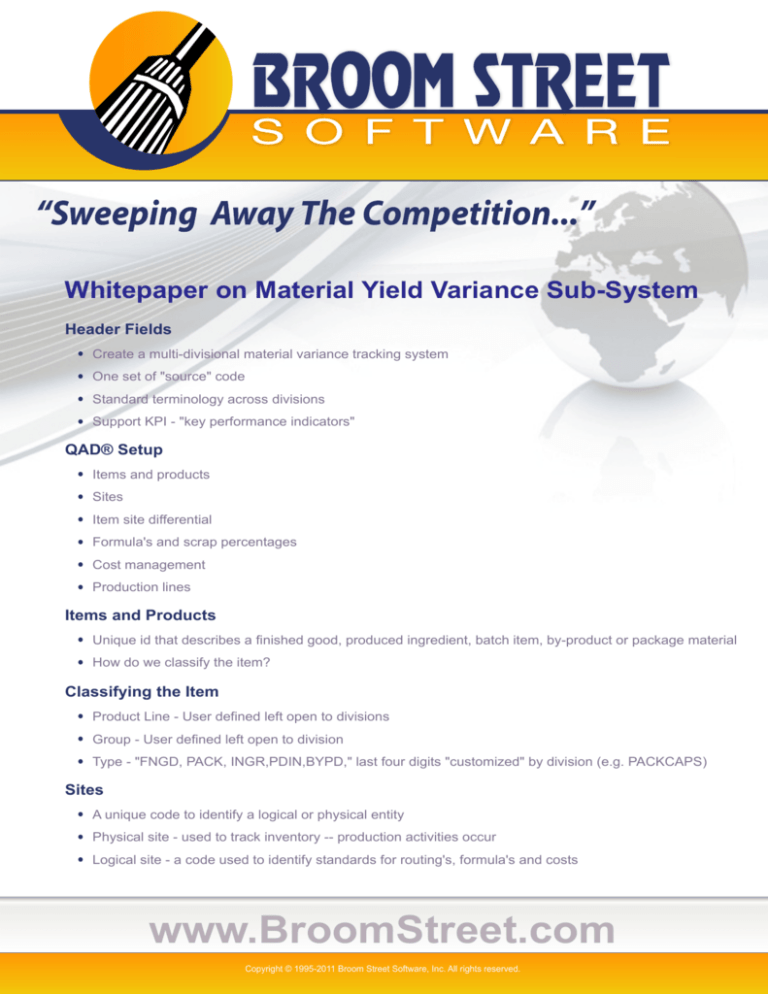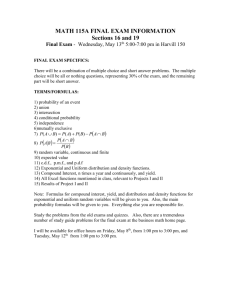
Whitepaper on Material Yield Variance Sub-System
Header Fields
Create a multi-divisional material variance tracking system
One set of "source" code
Standard terminology across divisions
Support KPI - "key performance indicators"
QAD® Setup
Items and products
Sites
Item site differential
Formula's and scrap percentages
Cost management
Production lines
Items and Products
Unique id that describes a finished good, produced ingredient, batch item, by-product or package material
How do we classify the item?
Classifying the Item
Product Line - User defined left open to divisions
Group - User defined left open to division
Type - "FNGD, PACK, INGR,PDIN,BYPD," last four digits "customized" by division (e.g. PACKCAPS)
Sites
A unique code to identify a logical or physical entity
Physical site - used to track inventory -- production activities occur
Logical site - a code used to identify standards for routing's, formula's and costs
www.BroomStreet.com
Copyright © 1995-2011 Broom Street Software, Inc. All rights reserved.
Item Site Differential
An item may have different formulas, routings and costs per site
Defines the differences between item-site planning maintenance, and item-site cost maintenance
Allows for tracking of "standards" and comparison analysis
Formulas
Set-up formulas
Attach scrap percentages to formulas
Attach formula to item and site
Create "N" number of formulas
Comparison reporting
Cost Management
Create logical costing sites
Enter costs for different sites
Cost set to cost set copy
Rollup costs
Yield reporting for cost sets
Yield Setup
Yield component
Yield parent
Site groupings
Yield Component
An item that is captured by the yield calculation to be used later in the reporting of actual
usage vs. standard
Components can be set up globally by product line, item type and group, e.g. all ingredients are
yield components
Yield Parent
An item which is used to drive standard production credit for all lowest level yield
components or lower level yield parents
Yield parents may be set up by product line, group and item types, e.g. all FNGD = yield parents
Site Grouping's
Site Grouping - A set of QAD sites linked together for the purpose of yield reporting
Have two facilities - have one yield report
Facilitate DCS Interface
www.BroomStreet.com
Copyright © 1995-2011 Broom Street Software, Inc. All rights reserved.
Standard Yield Terminology
Ideal standard usage (standard usage w/o scrap)
Standard usage (standard usage w/ scrap)
Ideal operational usage (operational usage w/o scrap)
Operational usage (operational usage w/ scrap)
Actual usage (ISS-WO)
Actual usage (inventory variances, CYC-CNT)
Standard Yield Terminology Continued...
Theoretical variance - (ideal standard - actual)
Formula variance - (standard - operational)
Operational variance - (operational - actual)
Opportunity variance - (ideal operational - actual)
Logical Yield Dataset
Production site group - list of sites where system searches for production (RCT-WO's)
Issue site group - list of sites where system searches for usage (ISS-WO') inventory variances
Standard site - the site the yield calculation uses to determine which standard formula to use
Operational site - the site the yield calculation uses to determine which formulas to use for capturing
operational usages and support variances to standard
Yield Control File
Setup defaults for yield execution
Setup defaults for yield reporting
QAD Execution
Work order release
Work order receipt/backflush
Cycle counting
Work Order Receipt/Backflush
Driver screen to produce necessary inventory transactions in QAD
RCT-WO - production credit
ISS-WO- actual usage
Modify backflush
Include scrap percentage in backflush
Production adjustments, backflush adjustments
www.BroomStreet.com
Copyright © 1995-2011 Broom Street Software, Inc. All rights reserved.
Cycle Counting
Used to report inventory variances that are not related to the production process
Types: recount, initial, cycle, tag
User defines which types yield will "pick up"
Yield Execution
Calculate scrap
Automatic allocation
Manual allocation
Calculate Standard / Operational Usages
System "pulls together" all "RCT-WO" transactions from production site group that are classified as a
yield parent and uses that number to extend the standard and operational formulas
Calculate Actual Usage
System "Pulls Together" all ISS-WO transactions from issue site group and matches them
up to a corresponding yield parent
Can ignore yield parent logic and post to direct repetitive labor parent i.e. "batches and produced
ingredients"
Automatic Allocation
System "pulls together" all cycle count activity and allocates the inventory variances to
those "yield parents" in which actual usage was reported against during the time period
All items in which no "ISS-WO's" transactions occurred during the time period will be flagged to
be manually allocated
Automatic Allocation
Flags can be switched to modify the behavior of automatic allocation in determining which
items need to be manually allocated
Variances are allocated based upon percentages of "ISS-WO's" that are backflushed against
production
Manual Allocation
The user determines which production item number will receive the variance that occurred
during the time period
Items can be allocated by a percentage basis and the system will recommend certain items that
will be used in the process
www.BroomStreet.com
Copyright © 1995-2011 Broom Street Software, Inc. All rights reserved.
Yield Procedures (Sample Flow)
Calculate scrap
Automatic allocation
Manual allocation
Verify "yield numbers"
If yield numbers do not match check yield setup, site groups, yield flags
Reporting
Item usage summary
Yield reporting
Item Usage Summary
Detail Breakdown of Transactions in QAD for certain time period
Summary yield information for each item
Calculates actual usage and compares to actual usage summarized by yield calculation
If no errors then yield system performed correctly
Benefits of Yield Dataset
Multiple comparisons
What if’s
Simulations
Flexibility in reporting
Yield Reporting
Daily, weekly, monthly, TYD
Flexibility
User creativity
Control file driven
Product line (department business unit)
Group (flavors, colors, sizes)
Item type (ingredient, packaging, by-products, produced ingredient)
Wild card reporting, multiple sorting
www.BroomStreet.com
Copyright © 1995-2011 Broom Street Software, Inc. All rights reserved.






